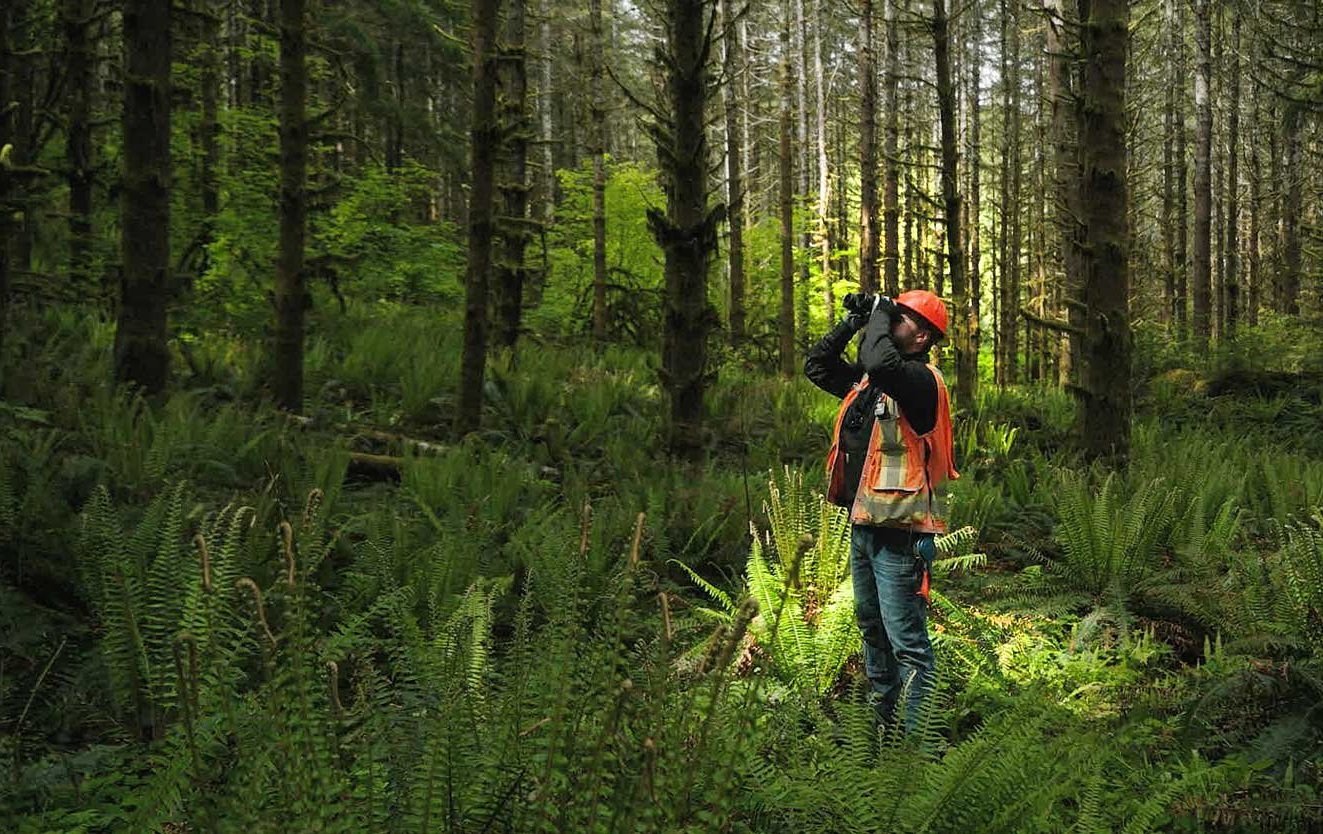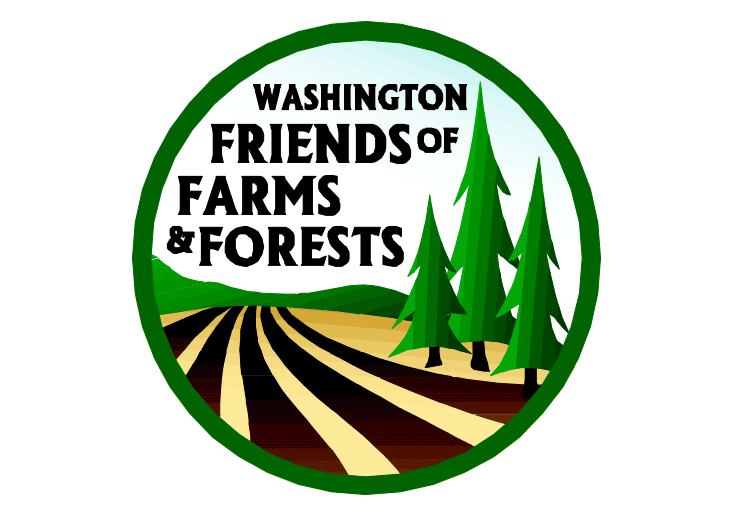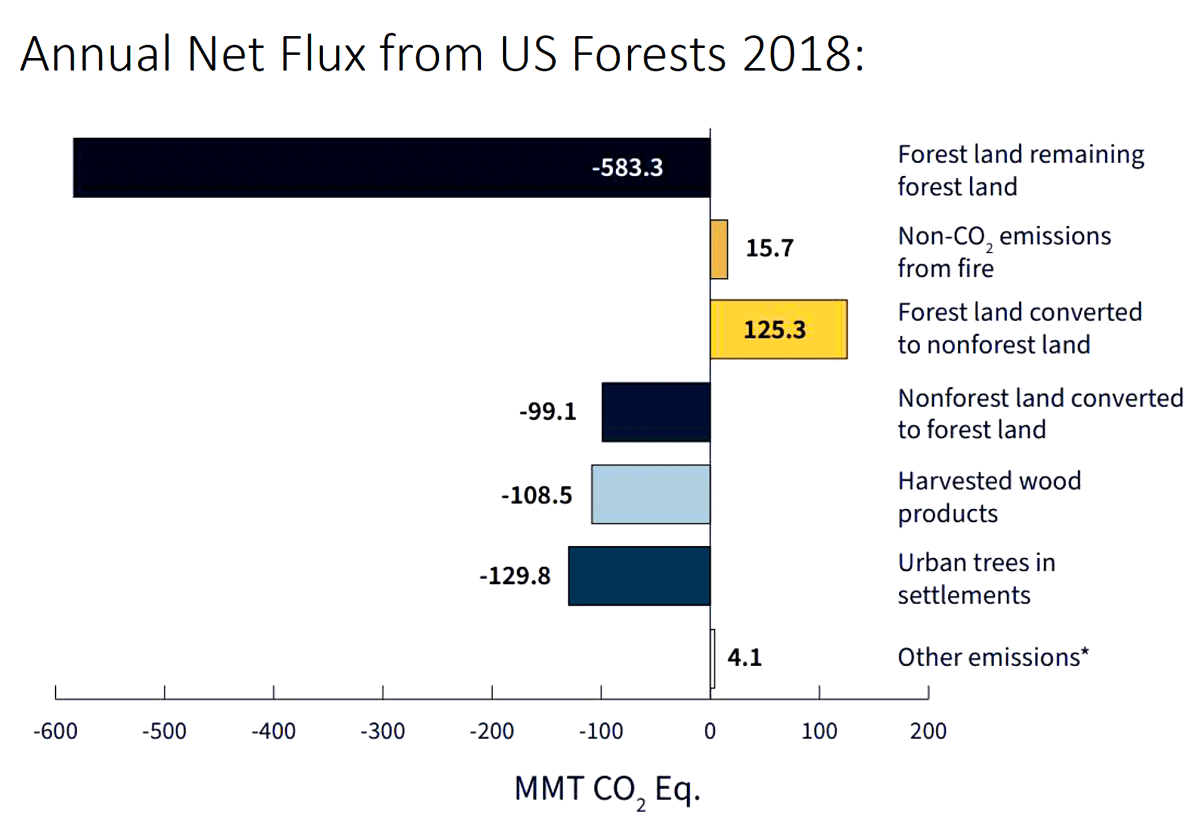
Carbon Blueprint for Washington’s Working Forests and Wood Products
Increasing carbon capture through continued active management and increased use of wood products.
Washington's working forests are crucial to meeting the state’s commitment to reduce net carbon emissions by 95 percent by 2050.
We are professional foresters, sustainability professionals, forestry researchers, engineers and wood manufacturers, and climate advocates.
This is our carbon blueprint for Washington, a plan to achieve the greatest level of climate mitigation from the working forests and forested landscapes we manage across the state.
Healthy, growing trees are the fastest way to remove carbon from the atmosphere.
No other state has a greater capacity to capture and store more carbon than Washington.
Forest ownership type and management style directly impact carbon-capturing performance.
Two primary forest risks constrain carbon capture – compromised forest health and land conversion.
Our carbon blueprint puts healthy,
productive and resilient forests at the center of Washington’s climate contributions.
Learn more about how the forestry and wood products industries are reducing our state’s carbon footprint at awc.org.
To realize the full potential of forests to capture carbon, we must remember that Washington has many types of forests that are managed for different objectives by diverse interests. Forest landowners from families, small private companies, publicly held corporations, conservation groups, tribes, and state and federal governments all play a part. Balanced, flexible and sustainable forest carbon policies will support our needs.

Nature’s Carbon Capturers
Healthy, growing trees are the fastest way to remove carbon from the atmosphere.
Trees pull carbon dioxide (CO2) from the air and use it to turn carbon into solid wood, releasing fresh oxygen in the process. This process is known as carbon sequestration. The faster a tree grows, the quicker it sequesters carbon.
Like most living things, a tree grows very quickly when it's young, and its growth rate inevitably slows as it ages. Older trees store more carbon, but younger trees remove more carbon dioxide from the air.
When we harvest, we transfer that carbon to a location where it will stay stored in products such as wood to build homes and buildings. We then replant, resetting the growth trajectory and more carbon sequestration.
The carbon in harvested trees remains in the wood for the usable life of the products it’s made into, which can be several decades or more. For example, the wood used to build a typical 2,000-square-foot home in the U.S. will store the equivalent of approximately 35 metric tons of CO2 for as long as the home stands. (Sources: Carbon Fundamentals, Lumber Weight, Board Footage).
Trees are our best and most natural way of removing carbon from the air, and the process of manufacturing wood building products takes relatively little energy compared to other building materials.
In addition, wood uses less fossil fuel to produce than conventional building materials. The embodied carbon (carbon emissions over a product’s life cycle) of building and construction materials accounts for 15% of global CO2 emissions (Why The Building Sector? – Architecture 2030). The demand for building stock is expected to double by 2060, making carbon-storing wood the best low-carbon, renewable climate solution for buildings.
The most responsible thing we can do for climate change is to strike a balance between older forests and growing forests. Policies that help us keep and enhance sustainably managed forests and produce renewable low-carbon wood products are two of the best ways to mitigate climate change and support rural economies.
Washington can achieve more climate mitigation than it is now by actively managing our working forests.

The Carbon Advantage
No other state has a greater capacity to sequester and store more carbon than Washington.
Washington is one of the best places in the world to grow and harvest trees.
(Source: calculated from Smith, James E., Heath, Linda S., Skog, Kenneth, E., Birdsey, Richard A. Methods for Calculating Forest Ecosystem and Harvested Carbon with Standard Estimates for Forest Types of the United States. Pennsylvania: USDA Forest Service, 2006)
#1 Best Place to Grow Trees
The state has the highest percentage of land in the high-site productivity class, which leads to extremely high growth rates. A stand of intensively managed Douglas fir, for example, absorbs more than 9 metric tons of CO2 equivalents (CO2e) per acre at its peak average growth – nearly 10 times more CO2e than Rocky Mountain lodgepole pine forests in the same region.
#2 in Softwood Lumber Production
The state is the second largest producer of softwood sawtimber in the U.S., even though timber harvesting volumes are half of what they were several decades ago. Substantial amounts of this timber become wood products (Source: Oregon Forest Facts, 2019-20 Edition, Page 8), such as building materials and furniture, that can continue storing the carbon they contain for another century or more. In turn, producing these sustainable and renewable building products supports our local economies.
Source: USDA Forest Service. “Forest Inventory EVALIDator 2.0.3.” Accessed October 30, 2022.
#2 For Greenest Energy
Washington's electricity grid has the second lowest CO2e electricity intensity of any state. With its robust infrastructure for manufacturing timber products and market access, Washington is one of North America's greenest places for producing wood products.

Forest Performance
Forest ownership type and management style impact carbon-capturing performance.
Washington’s ideal climate and productive soil, together with its robust and green manufacturing infrastructure, make it one of the best places in the world to grow trees and manufacture wood products.
Comparing Washington's Forests
While Washington is one of the best states for growing trees and sequestering carbon quickly, much of its forestland is performing well below its potential. These performance differences are primarily related to the type of ownership and management style involved.
Washington Forest Ownership
Source: Christensen, G. A., A. Gray, O. Kuegler, D. Siemann. 2020. Washington Forest Ecosystem Carbon Inventory: 2002-2016. USDA Forest Service, PNW Research Station and Washington DNR. PNW Agreement No. 18-C-CO-11261979-066. Figure 4.1.
Washington's working forests are primarily dominated by three management approaches:
Lands intensively managed by large private owners;
Lands intended to be managed for both conservation and resource production by Washington State's Dept. of Natural Resources (DNR); and
Lands primarily managed for conservation by the US Forest Service (USFS).
Forest Management Approaches
Large Private Landowners
The state’s private forestland owners produce more tree growth on average since their forests are typically younger and more intensively managed. These lands provide the most harvest for wood products.
Some harvested timber is left on-site in the forest or burned for energy in the manufacturing process. However, more than half of the carbon sequestered annually by Washington’s private forestland is stored long-term in wood products. Because a portion of this land’s annual growth stays in the forest, the total net sequestration is about 56% of a year's growth. Only 15% is lost to mortality.
Source: Graphs adapted from Ganguly, I., L. Droog, F. Pierobon. 2023. Global Warming Mitigating Role of Forests in Washington State, by Land Ownership Type. WSU annual report.
United States Forest Service
USFS lands, which are typically older and primarily managed for conservation, are in a very different place than private lands. USFS forests are growing or capturing less carbon on average per acre per year- 2.88 metric tons of CO2e/acre/year versus 4.9 metric tons of CO2e/acre/year on private lands. In addition, 70% of this annual growth is currently being lost to mortality. Although more carbon is accruing in USFS forests, minimal harvesting results in a total net sequestration of only 28% of annual growth.
Source: Graphs adapted from Ganguly, I., L. Droog, F. Pierobon. 2023. Global Warming Mitigating Role of Forests in Washington State, by Land Ownership Type. WSU annual report.
Washington Dept. of Natural Resources
Washington DNR manages over 2 million acres of forested state trust lands to generate revenue for schools and other public services through timber harvests. However, much of the land has been set aside for conservation. Mortality is about 32% of growth, which is twice as much as private lands and half of USFS lands.
Source: Graphs adapted from Ganguly, I., L. Droog, F. Pierobon. 2023. Global Warming Mitigating Role of Forests in Washington State, by Land Ownership Type. WSU annual report.
Overall Carbon Sequestration
A comparison of landowner types shows that private lands grow more per acre per year and retain more carbon in the forest or as wood products.
Source: Graphs adapted from Ganguly, I., L. Droog, F. Pierobon. 2023. Global Warming Mitigating Role of Forests in Washington State, by Land Ownership Type. WSU annual report.
Sustainable forestry and wood products are essential to achieving carbon neutrality by 2050.

Forest Risks
Washington State Has Two Primary Forest Risks - Compromised Forest Health and Land Conversion.
Two major forest risks present an ever-increasing problem with emissions.
Risk 1: Compromised Forest Health
Risks to forest health are showing up in our forests in multiple ways, with a large share of acres vulnerable to forest losses:
1.9 million acres in Washington state are vulnerable to significant attack from insects and diseases, with the vast majority of acres in eastern Washington. (Krist et al., 2014).
Washington DNR also identifies 2.7 million acres of unhealthy forest in central and eastern Washington (WA DNR, 2022).
Source: Krist, Frank J., Ellenwood, James R., Romero, Sheryl A., Woods, Meghan E., McMahan, Andrew J., Cowardin, John P., Ryerson, Daniel E., Sapio, Frank J., Zweifler, Mark O, 2013-2027 National Insect and Disease Forest Risk Assessment. Washington Office: U.S. Forest Service, 2014. Source: Washington Department of Natural Resources. 2020 Forest Action Plan Annual Report, 2022.
Source: Bruce Lippke, Maureen Puettmann, Elaine Oneil & Chadwick Dearing Oliver (2021) The Plant a Trillion Trees Campaign to Reduce Global Warming – Fleshing Out the Concept, Journal of Sustainable Forestry, 40:1, 1-31, DOI: 10.1080/10549811.2021.1894951
Mortality
Mortality on timberlands in the Pacific Northwest has increased by more than 50% since the 1970s. The vast majority of this mortality increase is on national forestland, with all other landowners combined making up a tiny share of this increase. This trend is seen nationwide, with forest mortality on U.S. national forest timberlands outpacing growth since 2016 (Oswalt et al., 2019).
Wildfire
The state is losing forests to wildfire at an increasingly rapid rate. Annual acres burned by wildfire have increased more than five-fold since the 1980s.
Zhuang et al. (2021) found that anthropogenic warming was a leading cause of increasing fire weather in the western United States.
Full citation: Zhuang, Yizhou, Fu, Rong, Santer, Benjamin D., Dickinson, Robert E., Hall, Alex. (2021) "Quantifying contributions of natural variability and anthropogenic forcings on increased fire weather risk over the western United States." PNAS118, no. 45 (November 2021): 1-9. https://doi.org/10.1073/pnas.2111875118
Average Acres Burned by Decade (Source, EPA 2022):
1980’s – 59,783 Acres
1990‘s – 64,501 Acres
2000’s – 178,298 Acres
2010’s – 337,960 Acres (+465% since the 1980s)
Overstocked Forests
Many stands are overstocked due to fire suppression and lack of management. Most of these overstocked areas are in national forests (USDA, 2022).
Nearly 1.5 million acres (30%) of national forest east of the Cascades is categorized as fully stocked or overstocked (USDA, 2022). This is nearly double the share of fully or overstocked forests in private or state forests east of the Cascades. Full citation: USDA Forest Service. "Forest Inventory EVALIDator 2.0.6" Accessed October 30, 2022.
Full citation: USDA Forest Service. "Forest Inventory EVALIDator 2.0.6" Accessed October 30, 2022.
“The reduction in timber harvesting on national forests caused the forests to grow crowded and many trees became weakened, creating the delayed result of many trees dying and rotting, being attacked by insects, and burning up in wildfires. These dead trees are releasing CO2 back into the atmosphere, offsetting the absorption of CO2 through the photosynthesis of living trees and so reducing the amount of carbon sequestered by these forests (lower net growth).” (Oswalt et al., Citation2019).
Risk 2: Land Conversion
Forestland in Washington has declined by 2.5 million acres since 1938 (Oswalt et al., 2019), with a decline of 394,000 acres (2%) between 2007 and 2019.
Impacts On Small Forestland Owners (SFLOs)
A growing population and the pandemic exacerbated the trend to de-densify, which is not good for the climate. Small landowners are at the highest risk of land conversion. Many are in the productive low-elevation forests, and taking these lands out of carbon sequestration and storage represents a huge loss for carbon – both in the forest and in wood products.
Western Washington SFLOs are expected to convert almost 80,000 more acres of land by 2030, with the majority to residential development. That equals 9% of all SFLO lands.
SFLOs are also experiencing faster rates of forest loss. Between 2007 and 2019, forests owned by small landowners declined by more than 100,000 acres, or 3.7% (Rabotyagov et al., 2021).
Full citation: Rogers, Luke & Rabotyagov, Sergey & Danley, Brian & Comnick, Jeffrey & Cooke, Andrew & Solemslie, Alec. (2021). "Washington's Small Forest Landowners in 2020: Status, trends and recommendations after 20 years of Forests & Fish". University of Washington School of Environmental and Forest Sciences. Funded by Washington State Legislature. January 11, 2021. Washington's Small Forest Landowners in 2020 (nrsig.org)
Impacts at the National Level
For many years, U.S. forests have been a huge net sink, meaning more carbon is removed from the atmosphere through growth than is emitted from combustion, decay, or harvest. The sources of emissions are non-CO2 emissions from fire and forest land conversion. Some of this conversion has been offset with afforestation, which is planting trees on land that had not been a forest recently.

The Solution:
Grow More Trees
Use More Wood
Healthy Forests and Wood Products Are Good for the Environment.
Our foresters and tree planters start the new forest growing again by replanting three trees for every one harvested. On average, just 2% of our working forests are harvested each year, providing a sustainable supply of carbon-storing wood products and healthy growing forests.
We envision Washington putting healthy, productive, and resilient forests at the center of its climate contributions by leveraging its existing strengths – its productive forests, strong forest sustainability assurances, and commitment to renewable energy and transportation.
Carbon Blueprint for Washington’s Working Forests:
Washington's working forests are crucial to meeting the state’s commitment to reduce net carbon emissions by 95 percent by 2050.
Healthy, growing trees are the fastest way to remove carbon from the atmosphere.
Trees use carbon dioxide from the air to turn carbon into solid wood, releasing fresh oxygen in the process. Healthy, growing trees are the fastest way to remove carbon from the atmosphere. Carbon can be stored either in the forest or wood products. The carbon in harvested trees remains in the wood for the life of the products it’s made into, for example, in our homes. Wood innovation with Cross Laminated Timber and engineered wood products reduces the carbon footprint of buildings when used as an alternative building material to steel/concrete and will continue to store carbon for the building’s service life.
No other state has a greater capacity to capture and store more carbon than Washington.
Washington is one of the best places in the world to grow and harvest trees:
Highest percentage of land in the high-site productivity class, which leads to extremely high growth rates.
Second largest producer of softwood sawtimber in the U.S.
One of North America's greenest places for producing wood products.
Forest ownership type and management style impact carbon-capturing performance.
Much of Washington’s forestland is performing well below its potential, primarily due to the type of ownership and management style:
Private forestland owners sequester more carbon per acre on average since their forests are typically younger and more intensively managed. These lands also store the most carbon in harvested wood products.
Public forests managed by Washington’s Department of Natural Resources are less intensively managed and provide less wood per acre than private lands.
U.S. Forest Service lands are typically older and even less intensively managed sequestering the least amount of carbon per acre in the forest and storage in the built environment.
Two primary forest risks constrain carbon capture – compromised forest health resulting in wildfire and land conversion.
Risks to forest health include insects, diseases, catastrophic wildfires and forests that have become too dense. The number of trees that are sick and dying in the Pacific Northwest has increased by more than 50% since the 1970s because of reduced management on public forest lands. In the last decade, 63% of the wildfires in Washington have started on unmanaged federal lands, which results in an immediate release of carbon stored in the forest.
Converting forestland to industrial, commercial or residential use is an increasing threat to small forestland owners (SFLOs) are at the highest risk for land conversion. By 2030, Western Washington SFLOs are expected to convert almost 80,000 more acres of land – much of which is in the productive low-elevation forests. This represents a significant loss of carbon sequestration and storage capacity.

Policies-Vision
In order for Washington State to leverage its existing strengths – its productive forests, strong forest sustainability assurances, and commitment to renewable energy and transportation – we envision a State that puts healthy, productive, and resilient forests at the center of its climate contributions.
Goal 1: Grow Markets for Forest Products
Forest management investments in healthy forests respond to healthy markets for forest products. These robust markets can 1) slow forest conversion to other land uses by providing a stable economic value, 2) provide the ability to manage forests for increased health, productivity, and resiliency by making responsible silvicultural treatments cost-effective, and support job growth and workforce development.
Incentives for using products in low-carbon building design
RCW 70A.65.260 creates the Climate Commitment Account. Subsection (1)(g) authorizes funding of programs, activities, or projects that promote low-carbon architecture. We support allocating funding to the Department of Commerce to establish a grant program for buildings that can demonstrate a lower carbon footprint.
We support the prioritization of affordable housing legislation. Any affordable housing legislation should include tax breaks for buildings that can demonstrate a lower carbon footprint.
We support BuildClean model legislation that will require state buildings to conduct Whole Building Life Cycle Assessment during the design phase.
Incentives for using forest residuals for products or energy
RCW 70A.65.260 (1)(f) allows for funding to be used for programs, activities or projects that achieve energy efficiency or emissions reductions in the agriculture sector, including i) fertilizer management ii) soil management iii) bioenergy and iv) biofuels. We support working with the Washington State Department of Agriculture to administer funding for the use and transportation of forest residuals to carbon beneficial projects (e.g., biochar, bioenergy, biofuel, and other products).
We supported the extension of the sunset date for the sales and use tax exemption on hog fuel (HB 1018/SB 5030), that was passed into law during the 2023 legislative session.
Goal 2: Grow Healthy Productive Forests
Washington is a great place to grow trees – we want to maintain or increase our forest area and ensure they are healthy, productive, and resilient.
Incentives for Post-fire planting and restoration (see SB 6281)
In 2022, DNR found that 20% of the approximately 48,000 high-severity burned acres in Eastern Washington and 20% of the approximately 14,000 high-severity burned acres in Western Washington have been assessed to have potential seed source limitations.* We support funding for state cost-share programs for postfire reforestation and rehabilitation to prevent these areas from limited forest and carbon renewal. *(Source: Table 5 2022 Work of Wildfire Assessment)
The state Legislature invested $2.1 million in the Natural Climate Solutions Account in the 2023-2025 budgets for DNR’s reforestation strategy activities, including strategy development, mapping, seed collection, and increasing public nursery capacity. We recognize that State investment and incentives for both public and private investment in seedling and nursery capacity for climate-resilient and improved-growth seedling stock are essential and call for sufficient public and private investment to ensure that access to these seedlings is available to all forest landowners.
Incentives for fire risk reduction
We support increased DNR and NFS staff capacity to streamline NEPA permitting to increase the number of acres that can be treated under the Good Neighbor Authority program to manage forest health and resilience better and reduce wildfire risks across public/private lands.
We support researching ways to quantify potential carbon emissions reductions associated with fire resiliency projects in offset or incentive programs.
Improved Forest Management (silvicultural practices)
We support changing the current offset protocol to be reflective of Washington State forest practices and regulations.
RCW 70A.65.270 (2)(b)(ii) creates within the Natural Climate Solutions Account authorizes funding for improved forest health and reduced vulnerability to changes in hydrology, insect infestation, and other impacts of climate change. We support establishing a grant program run by DNR to provide funding for increased forest health and resilience.
4. Incentives for Avoided Conversion
In RCW 70A.65.270 (2)(b) it authorizes the Natural Climate Solutions Account to provide funding for avoided conversion of natural and working lands. We support the legislative intent to allocate a minimum $10 million each biennium for riparian easement projects like the forest riparian easement program. We support grants from this funding to be used for forestry and agriculture riparian easements.
5. Afforestation incentives
RCW 70A.65.270 (2)(a)(viii) also authorizes the Natural Climate Solutions Account to be used for protecting or planting trees in marine shorelines and freshwater riparian areas sufficient to promote climate resilience, protect cold water fisheries, and achieve water quality standards. We support increased funds from this account to provide payments for afforestation on riparian buffers in agricultural lands as well as protection of riparian buffers in forests lands.
Goal 3: Improve Carbon Footprint Across the Value Chain
Washington is a great place to manufacture wood products and we support policies to reduce embodied carbon across all parts of the value chain, from transportation and harvest equipment, to mill and product use efficiency.
We support discussions about incentives for wood product manufacturers to invest in mill efficiency, including recovery and utilization of wood, energy consumption reduction, electrification of equipment, reduction of transportation, and time and motion efficiencies in transportation.
RCW 70A.65.260 (1)(f)(v) allows for the Climate Commitment Account funds to be sued for grants, rebates, and other financial incentives for agricultural harvesting equipment, heavy-duty trucks, and other equipment used in agricultural operations. We support working with the state Legislature to expand the authorization of CCA funding to include administering incentives for low-carbon equipment and transportation in the forest sector.
We support research and development in technology that makes chipping and transporting slash more efficient and feasible, such as log trucks that can still do the job they do today but run on electricity.
Washington’s Working Forest Carbon Blueprint Supporters




















